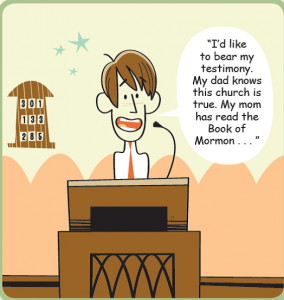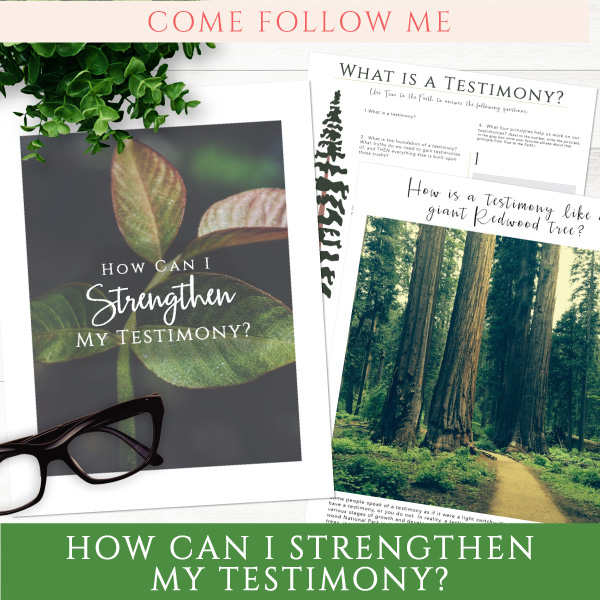How Can I Increase My Testimony? 4 Teaching Ideas by John Hilton III
How Can I Increase My Testimony?
By John Hilton III
Here are a couple of ideas that may be useful as supplements as you teach this class.
Teaching Idea #1
Share the following picture with the class:
What makes this comic funny? The point is that you have to know for yourself. Share with students this quote from Elder Richard G. Scott. He said, “Honestly evaluate your personal life. How strong is your own testimony? Is it truly a sustaining power in your life, or is it more a hope that what you have learned is true? . . . Does your testimony guide you to correct decisions?” (Richard G. Scott, “The Power of a Strong Testimony,” Ensign, November 2001, 87). Take a few minutes and invite students to answer Elder Scott’s questions.
Teaching Idea #2
Bearing testimony is important.
Share the following quote with students:
When Brigham Young called a new Young Mens President he told him, “At your meetings you should begin at the top of the roll and call upon as many members as there is time for to bear their testimonies and at the next meeting begin where you left off and call upon others, so that all shall take part and get into the practice of standing up and saying something. Many may think they haven’t any testimony to bear, but get them to stand up and they will find the Lord will give them utterance to many truths they had not thought of before. More people have obtained a testimony while standing up trying to bear it than down on their knees praying for it” (in Junius F. Wells, “Historic Sketch of the Y. M. M. I. A.,” Improvement Era, June 1925, 715).
Take time to reflect with students on the history of bearing their testimonies. Maybe you could share your history and then invite them to share theirs. As an example, here’s my history (it’s not great, but it’s all I’ve got):
I can still remember the first time I bore my testimony. I was about ten years old and was in our primary room. I was wearing a dirty coat and didn’t want to bear my testimony. But everyone else was doing it, so I got up and said (and this is about how I said it), “I’dliketobearmytestimonythatIknowthischurchistrue, I’mthankfulformyfamilyinthename of Jesus Christ Amen.”
Have you ever shared or heard a testimony like that?
I remember the second time I bore my testimony. I was twelve years old and it was at the end of a ward youth conference. I was a Deacon at the time, and every other deacon in my quorum had already borne his testimony. All the older Deacons were saying, “John, go bear your testimony!” I didn’t want to, but I did because of the peer pressure. That testimony was about as meaningful as the one I just mentioned.
I can also clearly remember the third time I shared my testimony. I was 15 at the time and was at EFY. Going into the testimony meeting, I really didn’t plan on bearing my testimony, but as the meeting went on, I really started to feel the Spirit. Finally, I got up and began to explain the feelings I had in my heart for the gospel. A feeling of warmth that came over me as I shared my testimony, and I felt the Spirit like I never had before. My testimony got stronger because I bore it. When I sat down, I felt so good. I learned for myself that a testimony was found in the bearing of it.
After students have shared some of their histories, talk a little bit about the importance of bearing testimony. You might want to invite some students to share testimony, either in class or at the next fast and testimony meeting. It’s also important to note that we can bear our testimonies at any time, not just in testimony meetings. We can share our knowledge of truth in conversations with friends, at home with our families, and using technology. We don’t have to wait for fast and testimony meeting to bear a testimony. We can bear our testimonies at any time, not just in testimony meetings. We can share our knowledge of truth in conversations with friends, at home with our families, and using technology. We don’t have to wait for fast and testimony meeting to bear a testimony, although that is a great opportunity to formally bear testimony as well.
Teaching Idea #3.
This one could be especially useful if you have students who are interested in basketball. The below picture pretty much sums up the idea, although you could take it to a higher level by having an actual basketball for a student to spin (don’t let the class spin out of control over this though!)
For most, receiving a testimony takes time—it doesn’t come overnight. We might be doing all the right things and still feel like we don’t have a testimony or that our testimony is not strong enough. Don’t get discouraged. Someone who is 6’4” didn’t become that height overnight, nor do talented piano players play Bach’s Minuet in G their first day. Remember that sometimes when we are seeking our testimonies, it’s not that we’re not doing the right things—we just haven’t done the right things long enough.
Alma the Younger said, “I have fasted and prayed many days that I might know these things of myself” (Alma 5:46; emphasis added). This teaches us that not only can fasting help us gain a testimony, but perhaps more importantly that it may take many days, or weeks, or months, or years.
Teaching Idea #4
One of the keys to living the gospel is to live it. The Savior taught, “If any man will do his will, he shall know of the doctrine” (John 7:17; emphasis added). In other words if we want to know if a gospel principle is true, we need to live that principle (do the things we are supposed to do).
For example, a young woman we know said that she never read her scriptures. She didn’t think they would help in her life. Then she starting having some problems and began to read the scriptures on a daily basis. As she read the scriptures everyday, she felt different. She felt better and though she still had problems she was able to work through them. She recently bore her testimony of the value of scripture study. She gained her testimony of scripture reading by reading the scriptures.
President Howard W. Hunter taught, “Action is one of the chief foundations of personal testimony. The surest witness is that which comes firsthand out of personal experience.
“. . . This, then, is the finest source of personal testimony. One knows because he has experienced” (Howard W. Hunter, Conference Report, April 1967, 115–16; emphasis added).
Here’s a little object lesson that can illustrate this point:
There are many levels of testimony:
I hope it’s true . . .
I think it’s true . . .
I believe it’s true . . .
I know it’s true . . .
For example, what if we told you that your ring finger is less flexible than your other fingers? Do you hope, think, believe, or know that is true? What is the only way to move from “hope” to “know”? We must experiment and test it out. Do the following:
- 1. Put your hands together, palm to palm
- 2. Keeping your palms together, see if you can separate your pointer fingers. Can you do it? Good, now keeping your palms together fold your pointer fingers over.
- 3. With your palms together and pointer fingers folded over, try to separate your pinkey fingers. Can you do it? Good. Now fold those over.
- 4. What about your thumbs, and your middle finger? Good. Fold those over.
- 5. Now with your palms firmly pressed together and all your fingers folded over except your ring finger, try to separate your ring fingers from each other. Interesting, isn’t it?
So how many of you now “know” your ring finger is less flexible than your others? Gaining a witness of spiritual things is much the same: When we first experiment and act in obedience, then the testimony comes.
Give students the options of some “experiments” they could try (or let them come up with their own). Experiments like, “Say 10 nice things to your mother today,” “Write in your journal every day this week,” etc. so that they can do something and increase their testimony of those principles as a result.
All images in this post are taken from the book HOW?by John Hilton III and Anthony Sweat.
John Hilton III has earned a reputation for being an amazing teacher, speaker and author! If you are a regular at Deseret Book, Time Out For Women, EFY or BYU Education Week, you probably already know him. We are SO lucky to have him sharing what he knows with us.
He was born in San Francisco and grew up in Seattle. He served a mission in Denver, and got a Bachelor’s degree from Brigham Young University. Along the way he met his wife Lani and they have five children. They have lived in Boise, Boston, Mexico and Miami. Currently, they live in Utah. John has a Masters degree from Harvard and a Ph.D from BYU, both in Education, and currently is an Assistant Professor of Ancient Scripture at BYU. He has also written several books with Deseret Book. Besides being with his family, his favorite hobbies are learning Chinese and doing humanitarian work. For more information visit www.johnhiltoniii.com
————-
See our popular study and teaching package HERE about how you can strengthen your Testimony. (May Come Follow Me Curriculum)
This teaching package has 5 different teaching and study activities to help those you are teaching dig and understand how to strengthen and bear their testimonies.
You can see more pictures and read more about this package HERE.








Where’s the print button so I can print the article not the stuff on the right.
Thanks so much for sharing your talents! Your ideas are truly so helpful and inspiring!
robin – highlight, edit/copy and then edit/paste on Word; then move each picture if you want them onto the document…i have Microsoft Word and that’s how i did it…..
robin – when you highlight, the stuff on the right gets highlighted too but no worries, when you get to the end, the stuff on the right gets un-highlighted
These ideas are amazing! Thank you so much for sharing it!!
Thank you SO much. I’m teaching this lesson Sunday and it is going to help me so very much. 🙂
These ideas were just what I was looking for!
Thank you so much for your wonderful ideas!!!!
I just love all these ideas! Thank you for sharing!
If you’d like some more ideas on an FHE lesson about increasing your testimony, please check out my article “Questions and Answers About Gaining a Testimony” here: http://fhelessons.wordpress.com/2013/09/17/questions-and-answers-about-gaining-a-testimony/
Also, on my blog, if you click on the “Why I Believe” tab at the top of the page, you can read some essays from regular, everyday people about how they received their own testimonies.
Thank you! I appreciate you sharing your creativity and spiritual insight!
Great ideas! Thanks for sharing them!
I really appreciate the time it took to put this together for us!
Just thought I’d let you know that your like to http://www.johnhiltoniii.com is misformatted. It needs a “:” in the url.